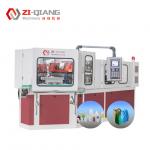Injection blow molding machines have more features in terms of
automation, environmental performance, maintenance convenience,
process scalability, etc.:
. Automation and intelligent upgrade
. Full servo drive technology ◦ The new generation of injection
blow molding machines uses servo motors to drive injection, mold
opening and closing, blow molding and other actions, with a
positioning accuracy of ±0.01mm, and a response speed that is 30%
faster than traditional hydraulic systems (such as injection speed
acceleration time from 0 to 200mm/s <0.1 second), and energy
consumption is reduced by another 20%-30%. ◦ Case: A certain brand
of servo injection blow molding machine produces 100ml cosmetic
bottles, with an energy consumption of only 0.03kWh/bottle, saving
0.02kWh/bottle compared to hydraulic models. Intelligent process
optimization system ◦ The control system equipped with AI
algorithms can automatically optimize parameters (such as real-time
adjustment of injection speed according to raw material temperature
and pressure fluctuations), reduce manual machine adjustment time,
and control the defect rate below 0.5% (the defect rate of
traditional models is about 1%-2%). ◦ Supports real-time monitoring
of OEE (overall equipment efficiency). Data such as production
capacity, energy consumption, and fault records can be viewed
through the touch screen, which is convenient for digital
management of the factory.
. Environmental protection and energy-saving design .
Low noise and low pollution ◦ The operating noise of the servo
system is less than 75dB (about 85dB for the hydraulic system),
which meets the environmental protection standards of the workshop;
the mold cooling adopts a circulating water system, and the water
resource utilization rate is greater than 95%, reducing industrial
wastewater discharge. ◦ Some models are equipped with exhaust gas
collection devices. For the irritating gases generated during the
production of materials such as PVC, they are discharged after
being filtered through activated carbon, which meets the VOCs
emission standards. Waste recycling and energy-saving
accessories ◦ It comes with a bottle embryo sprue material crushing
device, which can crush the sprue material (about 5% of the raw
materials) generated during the injection process and directly
reuse it in production, reducing the cost of raw materials (based
on an annual output of 10 million bottles, it can save about 50,000
yuan in raw material costs). ◦ The heating system uses
electromagnetic induction heating, with a heating efficiency of
>90% (the efficiency of traditional resistance heating is about
60%), and the surface temperature of the heating coil is <50℃,
which reduces the heat radiation in the workshop.
. Maintenance and operation convenience . Modular
structure design Each unit of the equipment (injection module, blow
molding module, control system) is installed in a modular manner.
When replacing parts, there is no need to disassemble the entire
unit. For example, it only takes 2 hours to replace the injection
screw (traditional models take 4-5 hours), and the maintenance
efficiency is increased by 50%. ◦ Key components (such as mold
guide pillars and screws) use self-lubricating materials (such as
hard chrome plating + PTFE coating), and the maintenance cycle is
extended to 5000 hours (about 2000 hours for ordinary parts).
Human-computer interaction optimization ◦ The touch screen supports
multi-language switching (Chinese/English/Japanese, etc.), the
operation interface is graphically displayed, and the training time
for novices is less than 1 day; the fault alarm system can display
the problem code in real time (such as "E003" means that the mold
is not locked) and provide solution prompts.
. Process expansion and special functions . Multi-layer
co-injection blow molding technology ◦ Some high-end models support
2-5 layers of co-injection blow molding, such as inner layer PE
(food contact) + outer layer EVOH (oxygen barrier) + middle
adhesive layer, which is used to produce high barrier sauce bottles
with oxygen transmission rate <0.05cc/day (single-layer bottle
is about 0.5cc/day). Embedded accessories integration ◦ Metal
threaded inserts, sealing rings and other accessories can be
directly embedded in the molding process. For example, when
producing medical bottles with threaded caps, the insert
positioning accuracy is ≤0.1mm to avoid assembly errors in the
later process. Special material adaptability ◦ Optimize the screw
structure (length-to-diameter ratio L/D=28-30) for biodegradable
materials (such as PLA, PBAT) to avoid thermal degradation of the
material. The tensile strength of the molded degradable bottle is
≥30MPa, which meets the ASTM D6400 standard.
. Product post-processing integration . Online
inspection and sorting ◦ Equipped with a visual inspection system,
it can detect online defects in bottle thread and cracks on the
bottle body, with an inspection speed of 500 bottles/minute and a
sorting accuracy of >99.9%, reducing the cost of manual quality
inspection (based on an annual output of 5 million bottles, it can
save 2-3 quality inspection personnel). Online printing and
labeling ◦ Some models integrate thermal transfer or screen
printing modules, and the pattern is directly printed on the bottle
body after molding. The overprint accuracy is ≤0.3mm, which is
suitable for small-batch customized production (such as customized
toiletries bottles for hotels).
. Safety protection design • Multiple safety
interlocks: The mold area and heating area are equipped with
infrared sensing devices, and the equipment automatically slows
down or stops when people approach; the hydraulic system is
equipped with pressure overload protection, and the pressure is
automatically relieved when the pressure exceeds 110% of the set
value to avoid the risk of pipe explosion. • Fireproof design: The
outer layer of the heating coil is wrapped with heat insulation
cotton + metal mesh to prevent the molten raw materials from
dripping and causing fire; the electrical cabinet has a built-in
temperature sensor, which automatically starts the cooling fan when
it exceeds 60°C. Summary The advanced features of the injection
blow molding machine are mainly developed around "intelligence,
greening, and flexibility", which not only improves production
efficiency, but also meets the diversified needs of high-end
products, environmentally friendly materials, customized
production, etc. In practical applications, these features can help
companies reduce costs and improve product competitiveness,
especially suitable for large-scale production scenarios with high
requirements for automation and product precision.









